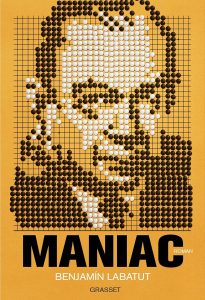Voilà un roman qu'on lirait bien d'une traite si le temps le permettait. Mais est-ce vraiment un roman au sens usuel ? La première partie, plutôt brève, est consacrée à la fin de vie tragique de Paul Ehrenfest (1880 - 1933). La seconde partie, la plus substantielle, est consacrée à la vie de John von Neumann (1903 - 1957), rapportée par ses proches, parfois illustres. La dernière partie, particulièrement palpitante, est consacrée à l'apprentissage automatique : la victoire en 2012 d'AlphaGo sur Lee Sedol (1983 - ). Paul Ehrenfest, bien connu des physiciens statisticiens et des probabilistes, est un trait d'union attachant entre Ludwig Boltzmann et la physique du vingtième siècle. Quant à John von Neumann, peu connu du grand public, il s'agit probablement de l'un des esprits les plus puissants et prolifiques de tous les temps, qui a profondément marqué les mathématiques, la physique, et l'informatique. On lui doit pêle-mêle, et entre autres contributions de premier plan, la mathématisation de la mécanique quantique, de la théorie des jeux, des méthodes de Monte Carlo, la conception de l'architecture des ordinateurs, et une préfiguration de l'intelligence artificielle. Ce roman, riche et divertissant, peut cependant donner l'illusion de faire le tour du personnage, tout comme par exemple le film de Christopher Nolan pour Julius Oppenheimer (1904 - 1967). Mieux vaut compléter cette lecture par quelques autres, comme par exemple l'autobiographie de Stanislaw Ulam (1909 - 1984), son grand ami, intitulée Adventures of a Mathematician, et par le livre écrit par sa fille, Marina von Neumann Whitman (1935 - ), intitulé The Martian's Daughter: A Memoir. Les écrits métascientifiques de John von Neumann restent encore utiles et enrichissants, notamment The Computer and the Brain, et surtout The Mathematician, qui aide à mieux penser les mathématiques et les mathématiciens.
Tout comme Andrei N. Kolmogorov (1903 - 1987), John von Neumann, contemporain des premiers bourbakistes, avait une envergure dépassant nettement les simples mathématiques.
Le titre MANIAC (Mathematical Analyzer Numerical Integrator and Automatic Computer Model) est le nom de l'un des premiers ordinateurs, conçu et exploité par John von Neumann pour le projet Manhattan dont sont issues les premières bombes atomiques. La couverture de la traduction française figure un portrait de John von Neumann avec des pierres du jeu de Go. Celle de la version anglaise d'origine figure le champignon d'une explosion nucléaire.
Voilà un roman autour de l'histoire d'Adele Gödel, née Porkert (1899 - 1981), épouse de Kurt Gödel (1906 - 1978), danseuse de cabaret au moment de leur rencontre. Kurt Gödel, parfois présenté comme le logicien le plus important depuis Aristote, est le père des fameux théorèmes d'incomplétude, qui ont transformé en utopie les rêves d'absolu des mathématiciens de son époque. Kurt Gödel avait un rapport au réel difficile, qui s'est dégradé au fil de sa vie. Certains n'hésitent pas aujourd'hui à le considérer comme présentant un profil dans le spectre de l'autisme, typique du syndrome d'Asperger. Cela signifie plus concrètement une difficulté importante à socialiser, à se projeter, à avoir de l'empathie, entre autres choses. Au-delà des étiquetages catégoriques forcément réducteurs, il est intéressant de constater que les personnes fortement atteintes de ces troubles sont souvent sauvées durablement par des anges gardiens, qui les accompagnent le long des années. Ce peut être une mère, un frère, mais aussi une épouse, comme dans le cas de Kurt Gödel. J'en connais plusieurs, et tous ne sont pas des scientifiques de premier plan, et réciproquement ! Ce roman a le mérite de faire découvrir la vie d'un couple ange-gardien-monstre-gardé d'Europe, entre le réel et le surnaturel, et à travers les vicissitudes du vingtième siècle. Kurt Gödel a quitté Vienne pour Princeton, où se trouvaient également Albert Einstein, John von Neumann, et bien d'autres réfugiés européens, pas du tout atteints du même trouble. La communauté scientifique, notamment mathématique, informatique, et physique, a développé une forme de tolérance et de bienveillance à l'égard des personnes vulnérables comme Kurt Gödel. Nous savons qu'ils tutoient les vertiges de l'absolu et de l'absurde. De The Big Bang Theory à The Playlist, l'époque est plutôt favorable aux « nerds ».
Vers 1930, les théorèmes de Kurt Gödel ont fasciné John von Neumann, épris d'axiomatisation.
Entre John von Neumann et Kurt Gödel ? Peut-être Alan Turing (1912 - 1954).
Ce roman de Yannick Grannec est paru en 2012, année de la victoire d'AlphaGo.
Chronologie sélective et récréative.
- Henri Poincaré (1854 - 1912)
- David Hilbert (1862 - 1943)
- Albert Einstein (1879 - 1955)
- Charles de Gaulle (1880 - 1970)
- Stefan Banach (1892 - 1945)
- Enrico Fermi (1901 - 1954)
- Eugene Paul Wigner (1902 - 1995)
- Andrei N. Kolmogorov (1903 - 1987)
- John von Neumann (1903 - 1957)
- Julius Oppenheimer (1904 - 1967)
- Henri Cartan (1904 - 2008)
- Jean Dieudonné (1906 - 1992)
- Jean Leray (1906 - 1999)
- Andre Weil (1906 - 1998)
- Kurt Gödel (1906 - 1978)
- Stanislaw Ulam (1909 - 1984)
- Georges Pompidou (1911 - 1974)
- Alan Turing (1912 - 1954)
- Mark Kac (1914 - 1984)
- Claude Elwood Shannon (1916 - 2001)
- François Mitterrand (1916 - 1996)
- Richard Feynman (1918 - 1988)

